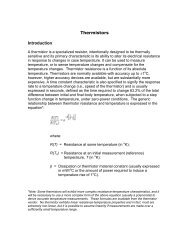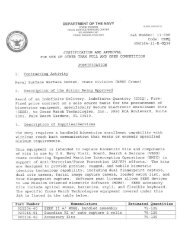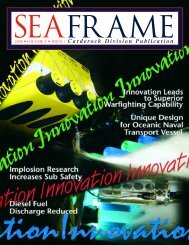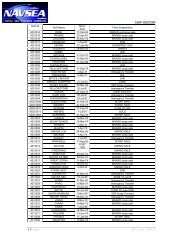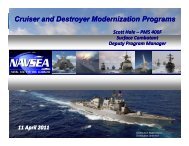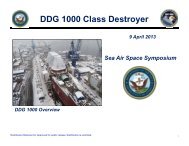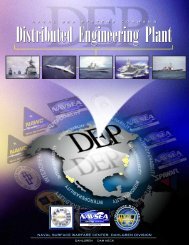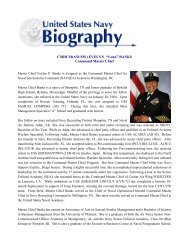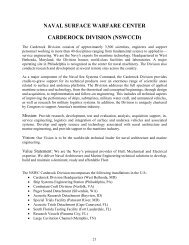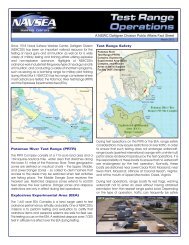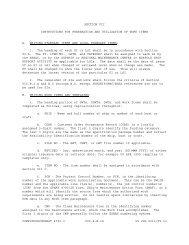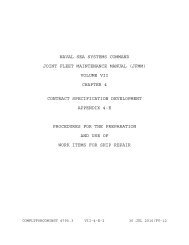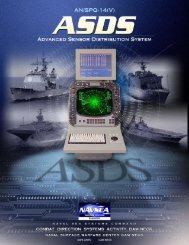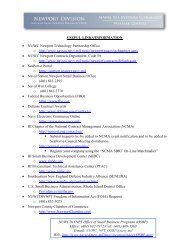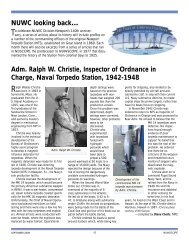Volume 6, Issue 1 - Naval Sea Systems Command - The US Navy
Volume 6, Issue 1 - Naval Sea Systems Command - The US Navy
Volume 6, Issue 1 - Naval Sea Systems Command - The US Navy
Create successful ePaper yourself
Turn your PDF publications into a flip-book with our unique Google optimized e-Paper software.
SEAFRAME<br />
28<br />
By<br />
William<br />
Palmer<br />
Core equities<br />
Saving At-<strong>Sea</strong> Acoustic Trial Costs<br />
Through Computer-Based Analysis<br />
Recently, researchers at the <strong>Naval</strong><br />
Surface Warfare Center, Carderock Division,<br />
were tasked to measure the acoustic<br />
signature of <strong>US</strong>S Florida (SSGN 728), a<br />
former Ohio-Class submarine which had<br />
been converted to the SSGN submarine class–a class<br />
capable of carrying payloads to support special warfare<br />
operations. Initially, the plan was to measure the boat’s<br />
signature with an outer appendage, called a Dry Deck<br />
Shelter (DDS), attached, and also without the DDS,<br />
for comparison purposes. Due to changing schedules<br />
and demands on the boat’s operating schedule, only<br />
one trial, with the DDS attached, could be executed.<br />
But the researchers came up with a way to measure the<br />
submarine’s “bare-hull” configuration without putting the<br />
boat through a second trial.<br />
<strong>The</strong> method, called signature decomposition<br />
analysis, was created from a process called beamforming,<br />
which enables trial personnel to pinpoint a noise source.<br />
<strong>The</strong> Florida’s trial was done in FY 07 and lasted for five<br />
days, during which the sub’s signature was measured.<br />
But, instead of putting the boat through a second<br />
trial, members of Carderock Division’s Performance<br />
Assessment, Modeling and Simulation, and Special<br />
Projects branch adapted the beamforming procedures to<br />
SIGNATURE<br />
DECOMPOSITION<br />
ANALYSIS<br />
predict the Florida’s bare-hull signature. Since the rest<br />
of the Ohio-Class fleet operates bare-hulled, there was<br />
plenty of prior trial data to corroborate the prediction.<br />
And the results were accurate, so accurate that the<br />
researchers presented their findings to program sponsors<br />
at NAVSEA’s SSGN program office, which concurred<br />
with the prediction, permitting the modeled signature to<br />
stand as a valid representation of the Florida’s signature.<br />
As a result, about $350K was saved in trial<br />
expenses. <strong>The</strong>se savings were realized across a broad<br />
range of concerns, such as eliminating logistical,<br />
hardware and operational risks associated with<br />
conducting such a trial; 5 to 6 days of ship time spent<br />
conducting the trial; and the cost associated with<br />
installing and removing a DDS. Because of their success<br />
in closely modeling the bare-hull signature, and because<br />
the model closely agreed with prior Ohio-Class data, the<br />
Carderock personnel have won the support of the Ohio<br />
Replacement Program. “This was one of the first of these<br />
types of analyses,” says Steve Jackson, a mechanical<br />
engineer, acoustic trials program manager, and liaison<br />
between the NAVSEA program office and Carderock<br />
Division. “It was a first on the SSGN/SSBN class. It’s<br />
SIGNATURE DECOMPOSITION (Continued on page 30)



